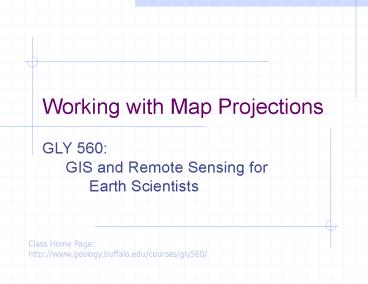Working with Map Projections PowerPoint PPT Presentation
Title: Working with Map Projections
1
Working with Map Projections
- GLY 560 GIS and Remote Sensing for
Earth Scientists
Class Home Page http//www.geology.buffalo.edu/c
ourses/gly560/
2
Map Projection
- The transformation from the geographic grid to a
plane coordinate system is referred to as map
projection. - Transformation from one plane coordinate system
to another is referred to as re-projection.
3
Ellipsoid (Global) Coordinate Systems
- Global coordinates based upon spherical
coordinates modified to account for imperfect
shape of earth.
4
Latitude-Longitude System
- The most commonly used coordinate system today is
the latitude, longitude, and height system. - The Prime Meridian and the Equator are the
reference planes used to define latitude and
longitude.
5
Equator and Prime Meridian
Meridian (N-S Longitude) Parallel (E-W
Latitude)
6
Latitude-Longitude Systems
- Degree-Minute-Second (DMS)
- 1 deg 60 min
- 1 min 60 sec
- Decimal Degrees (DD)
- 455230² 45.875
7
Plane Coordinate Systems
- René Descartes (1596-1650) introduced systems of
coordinates based on orthogonal (right angle)
coordinates. - These two and three-dimensional systems used in
analytic geometry are often referred to as
Cartesian systems. - Similar systems based on angles from baselines
are often referred to as polar systems.
8
Plane Coordinate Systems
- 2-D Systems(1 plane)
- 3-D Systems(2 orthogonal planes)
9
Projection Classes
- Conformal preserves local shape
- Equivalent preserves area
- Equidistant preserves length
- Azimuthal preserves directions
- Map can have more that one property, but
conformal and equivalent are mutually exclusive
10
Projections Affect Maps
The greater the map area, the greater the impact
of projection
11
Conic Projection
12
Cylindrical Projection
13
Azimuthal Projection
14
Common Map Projections
- Choice of map projection depends upon
- Attribute to be preserved
- Scale to be represented
- Aspect of the map
15
Transverse Mercator Projection
- Secant cylindrical projection
- Straight meridians and parallels intersect at
right angles. Scale is true at the equator or at
two standard parallels equidistant from the
equator. Often used for marine navigation because
all straight lines on the map are lines of
constant azimuth. - Requires
- Standard Parallels
- Central Meridian
- Latitude of Origin
- False Easting and Northing
16
Lambert Conformal Conic
- Secant conic projection
- Area, and shape are distorted away from standard
parallels. Directions true in limited areas. Used
for maps of North America. - Requires
- Standard Parallels
- Central Meridian
- Latitude of Projection Origin
- False Easting and Northing
17
Albers Equal-Area Conic
- Secant conic projection (similar to Lambert
Conformal Conic but preserves area instead of
shape) - Distorts scale and distance except along standard
parallels. Used in large countries with a larger
east-west than north-south extent. - Requires
- Standard Parallels
- Central Meridian
- Latitude of Projection Origin
- False Easting and Northing
18
Unprojected Maps
- Unprojected maps consider longitude and latitude
as a simple rectangular coordinate system. - Scale, distance, area, and shape are all
distorted with the distortion increasing toward
the poles.
19
Datum
- To project Earth to a flat plane we must choose
an ellipsoid or spheroid to represent the Earths
surface. - Choosing an ellipsoid implies a horizontal datum
for the projected map. - Hundreds of datums have been used.
20
Reference Ellipsoids
- Reference ellipsoids are usually defined by
semi-major (equatorial radius) and flattening
(the relationship between equatorial and polar
radii).
21
Selected Reference Ellipsoids
22
Clarke 1866 Datum (NAD27)
- Land-based ellipsoid running through Meades Ranch
Kansas - Basis for North American Datum of 1927 (NAD27)
still used today.
23
World Geodetic System 1984
- Determined from satellite orbit data.
- Identical to GRS80
- Used for North American Datum 1983 (NAD83)
24
NAD27 vs NAD83
- GIS Data providers switching from NAD27 to NAD83.
- NAD83 tied to global positioning system
measurements - Horizontal shift between NAD27 and NAD83 10-100 m
in conterminous US and gt200 m in Alaska.
25
Coordinate Systems
- Map projections used for small-scale maps
(lt11,000,000). - Plane coordinate systems used for large-scale
maps (gt124,000).
26
US Plane Coordinate Systems
- Universal Transverse Mercator (UTM)
- Universal Polar Stereographic (UPS)
- State Plane Coordinate (SPC)
- Public Land Survey System (PLSS)
27
Universal Transverse Mercator
- The National Imagery and Mapping Agency (NIMA)
(formerly the Defense Mapping Agency) adopted UTM
grid for military use. - UTM divides earths surface between 84N and 80S
into 60 zones about 360 km wide. - Each of 60 zones mapped onto transverse mercator
projection. - False origin assigned to each UTM zone. In
Northern Hemisphere, UTM measured from false
origin at equator and 500,000 m West of central
meridian.
28
UTM Zones
29
UTM Zones
30
UTM on USGS Maps
- On 7.5-minute quadrangle maps the UTM grid lines
are indicated at intervals of 1,000 meters, by
blue ticks in the margins of the map or with full
grid lines.
31
State Plane System
- In United States, State Plane System developed in
the 1930s and was based on NAD27. - While the NAD-27 State Plane System has been
superseded by the NAD-83 System, maps in NAD-27
coordinates (in feet) are still in use. - Most USGS 7.5 Minute Quadrangles use several
coordinate system grids including latitude and
longitude, UTM kilometer tic marks, and State
Plane coordinates.
32
Public Land Survey System
- Public Land Rectangular Surveys have been used
since the 1790s to identify public lands in the
United States. - Appears on large-scale USGS topographic maps
- Abbreviations used for Township (T or Tps),
Ranges (R or Rs), Sections(sec or secs), and
directions (N, E, S, W, NE, etc.).
33
Public Land Survey System
- Each state has a principle meridian running N-S,
and a baseline running E-W. - When measuring in a N-S direction, each square is
called a township. - When measuring in an E-W direction, each of these
squares is called a range.

